Introduction
India has the largest area under cultivation for rice, which is nearly 30% of the cultivated area around the world. Rice is one of the most important food crops in the world and feeds more than 60% of the Indian population.1 The first post-Green Revolution phase (from late-1960s to mid-1980s) was marked by a significant increase in productivity from otherwise poorly yielding but fertile land through the intensification of chemical and machinery inputs.2 As per the Directorate of Rice Development, Govt. of India, rice production has registered an appreciable increase from 20.58 million tonnes in 1950-51 to 104.86 million tonnes in 2014-15. The total yield was 668 kg/ha in 1951, which has increased to 2390kg/ha in 2015.
Despite the increase in chemical and technological inputs, the yields of rice have begun plateauing.1 Rice is a crop with a very high water requirement. It is a known fact that for every degree of rise in temperature (in absence of ideal rainfall), the productivity of rice is impeded by 10%.3 Furthermore, intensive rice cultivation has led to various ecological impacts such as decline in the ground water table, rising levels of pollution in the ground water, diversification in weed flora and more frequent and severe outbreaks of insect and pest diseases.4,5 From an agricultural point of view, it has severely impacted the soil structure, nutrient content and ultimately caused a decline in productivity.5 With the increasing yield gap, owing to the world’s ever increasing population, sustainable agricultural practices are gaining importance.6 Finding such solutions is further complicated by the looming danger of climate change.7 The only solution is through cost effective, eco-friendly and continuously evolving innovations in sustainable agricultural technology. 8
Sustainable agricultural practices include applying innovative farming approaches such as nutrient management in soil, integrated pest management, as well as soil and water conservation methods.9 Soil fertility replenishment does not only pertain to nutrients but its biological fertility as well. Microorganisms have long been known to have an intimate relationship with all plant life and play a significant role in crop health as well as productivity.3
Microorganisms hold the greatest promise for technological advances in crop production, crop protection, and natural resource conservation through soil, plant and environmental application.10 An example of innovation in microbial technology is the use of multi-microbial consortium to replenish the biological fertility of the soil. Though single organism products are now commercially available, they do not address the multifaceted requirements of nutrient exhausted soils. Buying multiple products is not a financially viable option for most Indian farmers, hence arises the need for a product containing a microbiome of highly selective microbes working in cohesion with each other to replenish the biological fertility of the soil.11 The advantages of such products include improving nutrient assimilation, strengthening crop immunity, reducing the effect of biotic and abiotic stresses as well as reducing the use of chemical inputs.12
This study involves an investigation of the efficacy of two such microbial products, Magicgro DripSOL and Magicgro Super for improving productivity and benefiting the farmers economically. Magicgro DripSOL is a proprietary formulation that is reported to enhance nutrient uptake in the rhizophere, accelerate soil conditioning and improves rhizopheric immunity. Magicgro Super is a commercially available microbial formulation that is reported to improve photosynthetic efficiency, alleviate abiotic stress and improve flower and fruit setting. Conclusively, the socio-economic impact of the product is also assessed.
Materials and Methods
Location
The field experiment was conducted in the kharif season of 2017 in Mandala District (22.6262° N, 80.5438° E) belonging to Jabalpur Division and Kotma town (23.2075° N, 81.9808° E) belonging to Anuppur district, Madhya Pradesh, India.
Cultivation Technique
The experiment was laid out across varying geographical areas on three distinct varieties of rice: two basmati varieties; PB-1, PS-4 and one non-Basmati variety; MTU-1010. The plots were maintained and cultivated by the organic method of cultivation. Fertigation applied was farm yard manure and green manure. No chemical fertigation or pesticide application was carried out during the particular crop cycle. The application schedule, dosage, mode of application was maintained uniformly across all the treated plots. Each plot size was 0.5 acre with sowing undertaken by the System of Rice Intensification (SRI method) of cultivation.13 For PB-1 variety, 12 plots of 0.5 acres were treated and correspondingly 8 plots of the same variety were observed as control (untreated) for data analysis. In case of PS-4 variety, 36 plots of 0.5 acres were treated and correspondingly 12 plots of the same variety were observed as control (untreated). For local variety MTU-1010, 28 plots (each of 0.5 acre area) were treated and 28 were observed as untreated. The treated rice plants were compared to the untreated rice plants of the same variety and an average was drawn. Since the trial was not a controlled study, no experimental design methodology was used. Table 1 describes the application schedule followed for the treated plots.
Table 1: Schedule followed for the utilisation of Magicgro DripSOL and Magicgro Super throughout the crop cycle.
| Timeline | Application | Mode of Application | Dosage |
|
Day 0 |
Sowing |
Not applicable |
Not applicable |
|
Day 12-15 post sowing |
Transplantation from nursery to field |
Not applicable |
Not applicable |
|
Day 17-20 post sowing |
1st application of Magicgro DripSOL |
Drenching |
250 gm/acre |
|
Day 65-70 |
1st application of Magicgro Super |
Foliar |
250 gm/acre |
|
Day 90-95 post sowing |
2nd application of Magicgro Super |
Foliar |
250 gm/acre |
|
Day 135-140 |
Harvest |
Not applicable |
Not applicable |
Biometric Parameters
The plant height, number of tillers and panicle weight was observed at harvesting stage. The rice crop was harvested at physiological maturity stage. Thirty plants from each unit area were chosen and observed for the mentioned parameters. The average of these observations per plot was further subjected to statistical analysis as mentioned below.
Yield Parameters
During harvesting, grains were separated from each plot for yield analysis, three 1m x 1m mark-up areas were demarcated and grains were separately harvested and dried under sun for three days. The grains were cleaned and consequently weighed to calculate the yield (total weight of grains harvested /meter2). The grain yield per acre was calculated and expressed in the units quintals per hectare.14
Statistical Analysis
Student’s t test was used based on PRISM-5 software and P values below 0.05 were considered statistically significant. The values in all graphs are an average of unpaired sample plots for all three varieties studied. All error bars represent standard error of mean.
Benefit-Cost Ratio
Benefit cost ratio was analysed to assess the economic impact of the use of the products Magicgro DripSOL and Magicgro Super. The benefit-cost ratio of each treatment was calculated by dividing net returns by cost of cultivation of respective treatments.14
Benefit-cost Ratio = Net returns (Rs acre-1) /Cost of Cultivation (Rs acre-1)
Results and Discussion
The results obtained from the field experiment have been summarized under following heads:
Plant Height
The plant height was measured prior to harvest of varieties PB1, PS4 and MTU-1010. The data was analysed and plotted as per Figure 1. The results showed a significant increase in all three rice varieties. The average plant height in PB-1 increased from an average of 104 cm in the untreated plots to 110 cm in the treated plots with a percentage increase of 5.7%. In case of PS-4, average plant height increased from an average of 97 cm in the untreated plots to 108 cm in the treated plots with a percentage increase of 131 cm. For the local variety MTU-1010, the average plant height increased from an average of 94.8 cm in the untreated plots to 110 cm in the treated plots with a percentage increase of 15.7%. Similarly, in another study it was observed that the highest increase in height was found in paddy after receiving 75% RDF + biofertilizers (Azospirillum and Phosphobacteria viz.) at all stages of its growth cycle.15 They attributed this to the fact that biofertilizers have the ability to mobilize nutritionally important elements from non-usable forms to usable forms. The heightened nutrient assimilation may give way to improving biometric characteristics such as plant height, number of tillers etc.
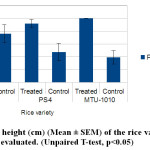 |
Figure 1: Plant height (cm) (Mean ± SEM) of the rice varieties was evaluated. (Unpaired T-test, p<0.05) Click here to View Figure |
Number of tillers
Tillering is an important agronomic trait for gauging rice population quality and grain production. It indicates extent of the panicle formation and thereby is an indirect indication of improvement in yields.16 The average number of tillers in PB-1 variety increased from an average of 11 tillers per plant in the untreated plots to 14 tillers per plant in the treated plots with a percentage increase of 27%. In case of PS-4, average number of tillers increased from 11 tillers per plant in the untreated plots to 14 tillers per plant in the treated plots with a percentage increase of 27%. For the local variety MTU-1010, the average number of tillers increased from an average of 11 tillers per plant in the untreated plots to 15 tillers per plant in the treated plots with a percentage increase of 36%.The data in figure 2 reveals that the mean number of tillers increased. This was a positive indication in terms of increasing productivity as an increase in number of tillers directly reflects increase in number of grain bearing panicles. The number of tillers is directly proportional to the increase in yield. These findings were in agreement with similar studies in which addition of phosphate solubilising organisms like Burkholderia sp. resulted in an increase of 5-10% in the number of tillers between the treated and control plants,17 even when the nutrient dosage was reduced to half. Similarly, another study claimed that co-supplementation of biofertilisers with fertilisers had a positive effect on the tiller formation in rice.1
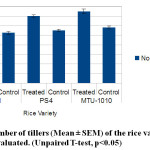 |
Figure 2: Number of tillers (Mean ± SEM) of the rice varieties was evaluated. (Unpaired T-test, p<0.05) Click here to View Figure |
Number of grains per panicle
The numbers of filled grains per panicle were studied for all the three rice varieties between the treated and untreated plants. In all three varieties as per figure 3, the number of filled grains per panicle was positively affected due to the treatment schedule between 12-16%. The number of filled grains per panicle in PB-1 variety increased from an average of 129 in the untreated plots to 145 in the treated plots with a percentage increase of 12.4%. In case of PS-4, number of filled grains per panicle increased from 118 in the untreated plots to 137 in the treated plots with a percentage increase of 16.1%. For the local variety MTU-1010, the number of filled grains per panicle increased from an average of 129 in the untreated plots to 148 in the treated plots with a percentage increase of 36%. Secondly, there was a significant impact on the number of grains per panicle as well as the weight of grains per panicle in all three varieties. This is in agreement with a study conducted on rice where the crop was treated with Azospirillum co-supplemented with nitrogen, the treatment resulted in 24% increase in number of grains per panicle.18 A similar study presented findings that addition of commercially available biofertilizer caused a significant improvement in the number of fertile grains per panicle amongst other parameters studied.19
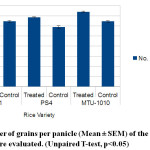 |
Figure 3: Number of grains per panicle (Mean ± SEM) of the rice varieties were evaluated. (Unpaired T-test, p<0.05) Click here to View Figure |
Weight of grains per panicle
The weight of filled grains per panicle was assessed amongst the treated and control plants across the three rice varieties (Figure 4). Improvement in the weight of grains also is a contributing factor towards improvement in yield. The weight of filled grains per panicle in PB-1 variety increased from an average of 2.64 grams in the untreated plots to 3.87 grams in the treated plots with a percentage increase of 46.5%. In case of PS-4, weight of filled grains per panicle increased from 3.31 grams in the untreated plots to 2.64 grams in the treated plots with a percentage increase of 25.37%. For the local variety MTU-1010, the weight of filled grains per panicle increased from an average of 3.26 grams in the untreated plots to 3.62 grams in the treated plots with a percentage increase of 11.04%. In another study, the highest panicle weight to a combined treatment of NPK + Azospirillum +PSB+ Vermicompost (2.59 g) as compared to standard recommended NPK + FYM (1.98 g)20. This was mainly due to better assimilation of photosynthetic product indirectly which could be attributed to better elemental nutrient assimilation and distribution in crop.
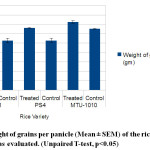 |
Figure 4: Weight of grains per panicle (Mean ± SEM) of the rice varieties was evaluated. (Unpaired T-test, p<0.05) Click here to View Figure |
Quantitative observations
The mean harvested yield was calculated in quintals per acre for each of the three varieties. The mean increase in yield was calculated. In case of PB1, the mean yield increased by 72% (from 19.46 q/hectare in the untreated plot to 34.06 q/hectare in the treated plot). For PS4, the mean yield increased by 55% (from 24.7 q/hectare in the untreated plot to 38.35 q/hectare in the treated plot). In case of MTU-1010, the percentage increase recorded was 36% (from 27.1 q/hectare in the untreated plot to 37 q/hectare in the treated plot). A comparative evaluation is present in figure 5.
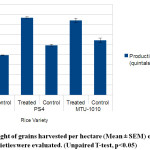 |
Figure 5: Weight of grains harvested per hectare (Mean ± SEM) of the rice varieties were evaluated. (Unpaired T-test, p<0.05) Click here to View Figure |
Similar to our findings, Tejaswini et al (2017)21 conducted a study on the effect of application of biofertilisers on two varieties of rice cultivated aerobically. Azospirillum, phosphorus solubilizing bacteria and potash mobilisers were used for this study and dosed at 5 kg/hectare. The nitrogen levels combined with biofertilizers were found to have a significant impact on grain yield for both the-cultivars. Maximum yield was obtained with the highest N level amended with biofertilizer in variety PA-6444.
A study was conducted in the Philipines where they evaluated the integrated effect of standard available biofertiliser on the productivity of rice under irrigated conditions22. They found that the overall increase in yield was between 0.2-0.5 t/ha. They further highlighted that the use of these product would be most optimum in low to medium input systems, where there is a lot of room for improvement. It would be important to test the efficacy of the products under conditions of abiotic stress. The efficacy of a product will vary depending upon the environmental factors that govern that particular crop cycle. Since academic trials occur only in optimal conditions for growth of the crop, these studies never provide any insight into how the product in question would perform under conditions of stress.
The timing, application methodology and doses during the crop cycle are just as important as suggested.23 They observed an increase in shoot and root length at seedling stage, followed by increase N uptake at the panicle post transplantation. However, it did not translate into a significant increase in yield in our study.
Benefit Cost Ratio Analysis
Table 2: Benefit cost ratio analysis of PB1, PS4 and MTU 1010.
| Variety | Average harvested yield (q/hectare) | Benefit-cost ratio | |
|
PB1 |
Treated |
34.06 |
3.3 |
|
Control |
19.76 |
3.02 |
|
|
PS4 |
Treated |
38.35 |
3.83 |
|
Control |
24.7 |
3.72 |
|
|
MTU-1010 |
Treated |
37.05 |
1.99 |
|
Control |
27.17 |
1.86 |
|
The cost benefit ratio for cultivating the two Basmati varieties and one local scented variety of rice was calculated. The total yield, the rate achieved per quintal was calculated and measured against the total expenditure incurred by the farmer were taken into consideration. Amongst the three varieties taken into consideration in this study, the proposed application schedule maximally benefited PB1 variety in terms of cost. The increase in yields in all three varieties was found to be statistically significant. In case of MTU-1010 being a local scented variety, the price it commands is much lesser than the basmati varieties, owing to which the benefit cost ratio is lesser. The improved benefit cost ratio, in all three varieties, therefore establishes the efficacy of the products Magicgro DripSOL and Magicgro Super economically.
In a similar study, the economic implications for improving the productivity of rice through benefit cost analysis1 were discussed. Among the different combination of nutrient source higher mean benefit cost ratio of 3.41 was recorded from nutrient applied NPK in the ratio 150:60:40 with supplementation of Azotobactor and phosphate solubilising bacteria in the ratio (5 kg/ ha). They postulated that this particular treatment significantly provided better yield in comparison to the other treatments thus implying that it has improved productivity, nutritional status and profitability on a long term basis.
The aim of this study was to assess the impact of microbial interventions in real time conditions as a part solution to the implementation of sustainable agriculture in commercial farming in India today. Magicgro DripSOL and Magicgro Super were tested and found to maximize the potential of the three rice varieties. Despite the varying geo-climatic conditions, the results remained consistent with a favourable improvement in the cost benefit cost ratio.
During the execution of this project, the region faced a drought of unparalleled severity. The untreated plots suffered major losses as the crop was not able to withstand the onslaught of abiotic stress and resulted in poor yields. The treated plots were still able to reach the average productivity for the particular varieties despite being rainfed. This study will be continued over time and definitive data will be obtained through trials conducted with various agricultural universities. It is important that the industry and Government work towards the development of products that are able to perform consistently with maximum benefit to the farmers of our country.
Acknowledgment
The authors would like to thank Mr. R. Krishnamoorthy for his valuable inputs and Mr. Shriram Patel for his field assistance. The authors would like to thank all the participant farmers for their excellent cooperation and participation in this exercise.
Conflict of Interest
All the authors of this paper declare that they have no conflict of interest in publishing this paper.
References
- Singh R. K., Kumar P., Prasad B., Singh S. B. Effect of Biofertilizers on Growth, Yield and Economics of Rice (Oryza Sativa L.). International Research Journal of Agricultural Economics & Statistics. 2015; 6(2): 386-391.
CrossRef - Kenekar A. A. Sustainable Agriculture: The key to India’s Deliverance. MEDC Maharashtra Economic Digest. 2017; XLVI(12): 76-70.
- Reid A. and Greene S. E. How Microbes Can Help Feed the World. Presented at American Academy of Microbiology Colloquium: December 2012; Washington, DC.
- Kanmony J. C. and Elpinston G. G. Impact of Ecological and Economic Factors on Rice Farming: A Case Study of Kanyakumari District. Journal of Rural Development. 2014; 33(1):83-100.
- Clercq M. D., Vats A. and Biel A. Agriculture 4.0: The Future of Farming Technology presented at World Government Summit; February 2018; United Arab Emirates.
- Yohannes H. A Review on Relationship between Climate Change and Agriculture. Journal of Earth Science and Climate Change. 2016; 7(2):1-8. DOI: 10.4172/2157-7617.1000335
CrossRef - Anadon L. D., Chan G., Harley A. G., Matus K., Moon S., Murthy S. L., Clark W. C. Making technological innovation work for sustainable development. Proceedings of the National Academy of Sciences. 2016, 113(35): 9682–9690. DOI: 10.1073/pnas.1525004113.
CrossRef - Farooq M., Siddique K. H. M. Conservation Agriculture. Switzerland; Springer International Publishing; 2015. DOI: 10.1007/978-3-319-11620-4_22.
CrossRef - Nayak C., Mahinta R. and Dash S. Economic Benefits of System of Rice Intensification (SRI) in Kendrapara District of Odisha. International Journal of Applied and Pure Science and Agriculture. 2016; 2(6):220-225. e-ISSN: 2394-5532, p-ISSN: 2394-823X
- Rana S. S. and Kumar S. Research Techniques in Agronomy. Department of Agronomy, College of Agriculture, CSK Himachal Pradesh Krishi Vishvavidyalaya, Palampur, 2014; 64 pages.
- Bhatt R., Kukal S. S, Busari M. A., Arora A., Yadav M. Sustainability Issues on Rice-Wheat Cropping System. International Soil and Water Conservation Research. 2016; 4(1):64-74. DOI:http://dx.doi.org/10.1016/j.iswcr.2015.12.001
CrossRef - Higga T. and Parr D. Beneficial and Effective Micoorganisms for a Sustainable Agriculture and Environment. Atami, Japan; International Nature Farming Research Centre; 1994. Pages 1-25
- Roy M., Saha S., Das J., Srivastava R. C. Technologies of Microbial Inoculation in Rice – A Review. Agricultural Review. 2015; 36(2):125-132.
CrossRef - Sun W. L., Zhao Y. G., Yang M. Microbial fertilizer improving the soil nutrients and growth of reed in degraded wetland. Presented at 3rd International Conference on Advances in Energy, Environment and Chemical Engineering May 26-28, 2017; Chengdu, China.
- Wijebandara D. M. D. I., Dasog G. S., Patil P. L. and Hebbar M. Response of rice to nutrients and bio fertilizers under conventional and system of rice intensification methods of cultivation in Tungabhadra command of Karnataka. Karnataka Journal of Agricultural Sciences. 2009; 22(4): 741-750.
- Wang Y., Lu J., Ren T., Hussain S., Guo C., Wang S., Cong R. and Li X. Effects of nitrogen and tiller type on grain yield and physiological responses in rice. AoB PLANTS. 2017; 9: plx012. doi:10.1093/aobpla/plx012
CrossRef - Khan M. M. A., Haque E., Paul N. C., Khaleque M. A., Al-Garni S. M., Rahman M. and Islam M. T. Enhancement of Growth and Grain Yield of Rice in Nutrient Deficient Soils by Rice Probiotic Bacteria. Rice Science. 2017; 24(5): 264-27. URL: http://dx.doi.org/10.1016/j.rsci.2017.02.002
CrossRef - Khorshidi Y. R., Ardakani M. R., Ramezanpour M. R., Khavazi K. and Zargari K. Response of Yield and Yield Components of Rice (Oryza Sativa L.) to Pseudomonas fluoresence and Azospirillum lipoferum under Different Nitrogen Levels. American-Eurasian Journal of Agriculture and Environmental Science. 2011; 10(3): 387-395.
- Rahmani A., Maleki A., Mirzaeiheydari M. and Naseri R. Effect of Plant Growth Promoting Rhizobacteria (PGPR) and Planting Pattern on Yield and Its Components of Rice (Oryza Sativa L.) in Ilam Province, Iran. International Journal of Biological, Veterinary, Agricultural and Food Engineering. 2014; 8(8): 912-918.
- Naveen G. N., Studies on effect of organics and microbial inoculants on growth and yield of aerobic rice (Oryza sativa ). Thesis submitted for the award of the degree of Master of Science (Agriculture) to University of Agricultural Sciences, Bengaluru; 2011.
- Tejaswini M., Sreedevi B., Akula B., Kumar B. A., Singh A. Effect of Cultivars and Biofertilizers on Growth, Yield and Nutrient Content of Aerobic Rice (Oryza sativa L.) Environment & Ecology. 2017; 35(4C): 3022-3027. ISSN 0970-0420
- Banayo N. P., Cruz P. C., Aguilar E. A., Badayos R.B. and Haefele S. M. Evaluation of Biofertilizers in Irrigated Rice: Effects on Grain Yield at Different Fertilizer Rates. Agriculture. 2012; 2: 73-86. DOI: 10.3390/agriculture 2010073
CrossRef - Kennedy, I. R., Choudhury, A. T. M. A., Kecskés, M. L., Rose, M. T. Efficient nutrient use in rice production in Vietnam achieved using inoculant biofertilizers. Proceedings of a project (SMCN/2002/073) workshop. 12–13 October 2007; Hanoi; Vietnam.

